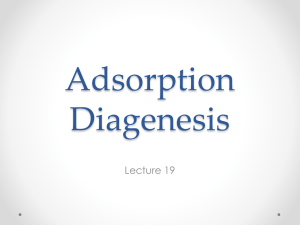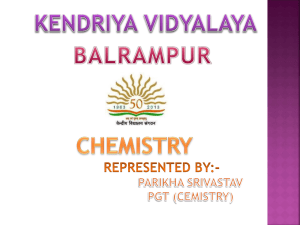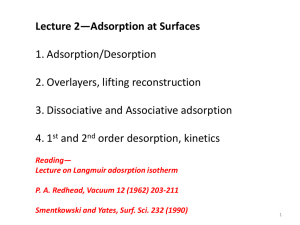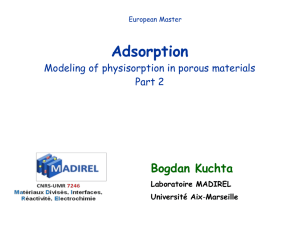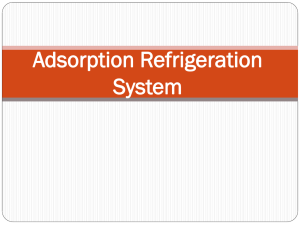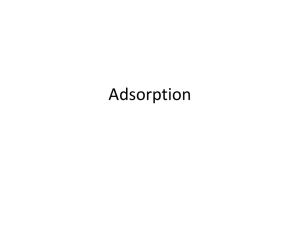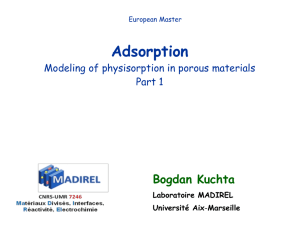Presentation 7
advertisement
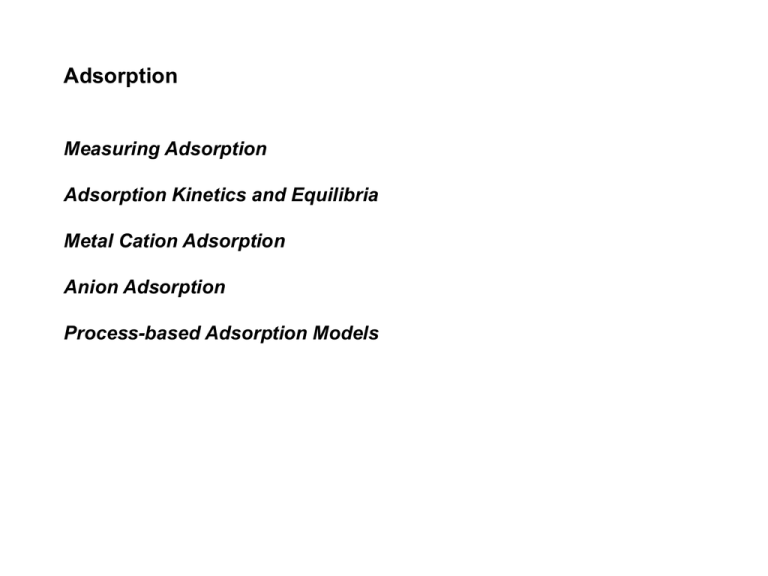
Adsorption
Measuring Adsorption
Adsorption Kinetics and Equilibria
Metal Cation Adsorption
Anion Adsorption
Process-based Adsorption Models
Measuring Adsorption
Adsorption defined as surface excess with respect to bulk soil solution
mqi = ni - VCi
where
qi is moles of species i per unit mass of adsorbent
ni is total moles of species i in the system
ci is solution concentration of species i
m is mass of adsorbent
V is solution volume
Batch and flow methods for determining
In either, reaction time should be long enough to allow accumulation of adsorbate
but short enough to avoid side reactions like precipitation / dissolution, redox or
degradation
Example
Soil / solution suspension consisting of 0.010 kg soil and 0.040 L water
contains a total of 0.005 mol Ca and has a [Ca] = 0.040 M
q = (n – VC) / m
q = (0.005 mol – 0.040 L x 0.040 M) / 0.010 kg = 0.34 mol kg-1
Soil / solution suspension consisting of 0.010 kg soil and 0.040 L water
contains a total of 0.010 mol Cl and has a [Cl] = 0.300 M
q = (0.010 mol – 0.040 L x 0.300 M) / 0.010 kg = -0.20 mol kg-1
Commonly, adsorption determined from change in solution concentration
qi = V(C0 - Ci)
Of course, one is never quite sure that a change in solution concentration is,
in fact, due to adsorption
Semi-proof would come from knowledge of mineralogical composition of soil,
together with spectroscopic data for reaction product(s) given by pure mineral(s)
Adsorption Equilibria
Equilibrium is not instantaneous in any case but often effectively instantaneous
Recall earlier example of cation adsorption in which approach to equilibrium was
limited only by diffusion
But for specific adsorption (with inner-sphere surface complex formation),
approach to equilibrium is much slower
If instantaneous equilibrium does not occur, general kinetic expression applicable,
dCi / dt = Rf - Rr
Otherwise, isotherms, qi = F(ci), for constant T and P used to describe the
partition of species i between adsorbed and solution phases
General types, S, L, H and C Isotherms
S curves have initially small slope that increases with increasing adsorptive
concentration
Possible explanations include
Solution phase complexation of the adsorptive as with complexation of dissolved
Cu by dissolved organic matter (high affinity for complexation)
Once capacity of dissolved organic matter to complex Cu reached,
adsorption proceeds
Cooperative interactions of the adsorbed species
Increasing extent of adsorption leads to increased affinity for adsorption
L curves have initially steep but decreasing slope with increasing
concentration of the adsorptive
Shape due to initially high affinity but decreasing area (number of sites) for
continued adsorption as the extent of adsorption increases
Langmuir and Freundlich are example models
S = kSMC / (1 + kC)
S = kCN
Langmuir can be developed from above concept that extent of adsorption is
proportional to the concentration of adsorptive, C, but decreases with extent
of adsorption
dS / dt = kfC(SM – S) - krS
Langmuir can be used in conjunction with a site affinity distribution function
to derive other isotherms
qi / Qi = ∫ (Ck(x) / (1 + Ck(x)) G(x) dx
where G(x) is the site affinity distribution function
H curve is exaggerated form of L
Often due to inner-sphere surface complex formation
C curve has constant slope, with neither increasing (S curve) nor
decreasing (L or H curves) slope with increasing concentration of the
adsorptive
Metal Cation Adsorption
Strength of adsorption
Inner-sphere >
Outer-sphere >
Diffuse ion swarm
Inner-sphere, electronic structure of surface functional group and
metal cation control adsorption
Outer-sphere complexation, similar to inner-sphere but smeared-out surface charge
and cation valence partly control
Diffuse ion swarm affected only by surface charge and valence
Inner-sphere complexation
For constant Z, tendency increases as ionic potential, Z / r, decreases
Small Z / r (large r) species will lose hydration water (easier to de-solvate)
and form inner-sphere complex with surface functional group
Small Z / r (large r) species more easily polarized by electronic field of
surface functional group, leading to ~covalent bonding
Cs+ > Rb+ > K+ > Na+ > Li+
Ba2+ > Sr2+ > Ca2+ > Mg2+
But trend for transitional metals
Cu2+ > Ni2+ > Co2+ > Fe2+ > Mn2+
more difficult to account for
pH effects on metal cation adsorption
Via surface charge, σH (pH increases, σH becomes more -)
Adsorption edge, qi = F(pH)
Generally, if high pH is necessary for adsorption, affinity low
pH50
pH50Na > pH50Cs but adsorption Na+ < Cs+
Since hydrolyzed species are more easily de-solvated, if appreciable
hydrolysis occurs below pH50, M(OH)n(m-n)+ is involved in adsorption process
7.
pH
mmole / kg
[Mg2+] / [Mg2+]max
2.48
2.73
0.72
1.08
0.090
0.135
3.05
3.20
1.80
2.14
0.225
0.268
3.36
3.80
4.10
2.45
3.64
4.21
0.306
0.455
0.526
5.00
6.00
6.35
8.00
0.794
1.000
Role of complexing ligands in solution
M(ad)
ML(ad)
L(ad)
Anion Adsorption
Inner-sphere > outer-sphere > diffuse ion swarm
Among common anions in soil solution,
B(OH)4-, (H2PO4-, HPO42- and PO43-) and COO- tend to form inner-sphere
Cl-, NO3- and, to some extent, HCO3-, CO32- and SO42-, outer-sphere or
to be adsorbed in the diffuse ion swarm
Inner-sphere complexation
Involves ligand exchange of the anion for either surface bound water
(protonated hydroxyl) or hydroxyl
SOH + H+ SOH2+
SOH2+ + Ll- SL(l-1)- + H2O
or
SOH + Ll- SL(l-1)- + OH-
Favored by pH < PZNPC, however, persists beyond
Evidence from spectroscopic and pH measurements
Outer-sphere
SOH2+ + Ll- SOH2+LlSMm+ + Ll- SMm+Ll-
In either case, ligand is hydrated so that there is no direct contact
Evidence that anions like Cl- are either adsorbed as outer-sphere complexes
or in the diffuse ion swarm
These species are readily displaced (exchanged)
Adsorption substantially decreases as PZNPC approached
May exhibit negative adsorption
Adsorption (mol / kg)
qi = (1/ms) [ci(x) –c0i] dV
which may be negative as in the previous example
Soil / solution suspension consisting of 0.010 kg soil and 0.040 L water
contains a total of 0.010 mol Cl and has a [Cl] = 0.300 M
q = (0.010 mol – 0.040 L x 0.300 M) / 0.010 kg = -0.20 mol kg-1
An exclusion volume can also be calculated,
VEX = [(1/ms) [ci(x) – c0i] dV] / c0i = -qi / c0i, which for this example would be
VEX = -0.20 mol kg-1 / 0.300 M = -0.667 L kg-1
VEX / VH2O = 0.667 / 4 = 0.167 so peak BTC of pulse at 0.833 PV
pH effects on anion adsorption
Via surface charge, σH (pH decreases, σH becomes less -)
favored at pH < ZPNPC
However, for an anion that becomes protonated, this effect is offset
-at low pH protonation of the adsorptive renders it non-adsorbed
Adsorption envelope, qi = F(pH)
Compare adsorption envelopes for monoprotic and di- / triprotic anions
Molecular Adsorption Models
Gouy-Chapman (Diffuse Double Layer)
Stern Modification
Constant Capacitance Models
Gouy-Chapman
For space normal to a planar charged surface and non-interacting point charges
in solution with only two species of same valance, c+ and c1. Beginning by equating electrochemical potentials of a species in the
diffuse ion swarm and bulk solution, derive the Boltzmann distribution relating
concentration, c+/- at any position x to the electric potential at x, Ψ(x),
c+(x) = c+0 exp(-z+Ψ(x) / RT)
c-(x) = c-0 exp(z-Ψ(x) / RT)
2. Relate charge density, ρ(x) = Σ ciziF, to potential using the Poisson equation
for this one-dimensional space,
d2Ψ / dx2 = F(ρ) = G(c+(x), c-(x))
and solve this equation to find the relationship, Ψ = H(x)
More explicitly,
d2Ψ / dx2 = -4πρ / ε = -(4π / ε) zFc0 [exp(-zFΨ / RT) – exp(zFΨ / RT)]
Derivations combine parameters to simplify operations but arrive at
(dΨ / dx) d (dΨ / dx) = -(4π / ε) zFc0 [exp(-zFΨ / RT) – exp(zFΨ / RT)] dΨ
which is integrated to
(dΨ / dx)2 = (8π / ε) RT c0 [exp(-zFΨ / RT) + exp(zFΨ / RT)] + B
or
dΨ / dx = -{(8π / ε) RT c0 [exp(-zFΨ / RT) + exp(zFΨ / RT) – 2]}1/2
where B = - 2 (8π / ε) RT c0 since if x is large, both dΨ / dx and Ψ are 0
This is the same as Sposito Eq. 8.16 if the exponentials were expressed
as concentrations as per Boltzman and since 4π / ε = 1 / ε0D
This expression is then integrated, i.e.,
dΨ / {(8π / ε) RT c0 [exp(-zFΨ / RT) + exp(zFΨ / RT) + 2]} = -dx
using hyperbolic identities to simplify the matter and a constant of
integration is determined as zFΨ0 / RT at x = 0.
But to obtain an explicit dependence of Ψ on x, more identities are needed to
finally arrive at,
Ψ = (2RT / zF) ln [exp(κx) + tanh(zFΨ0 / 4RT)] –
(2RT / zF) ln [exp(κx) - tanh(zFΨ0 / 4RT)]
where κ = 8πz2F2c0 / εRT
3. This establishes c+/- (x)
c+(x) = c+0 exp(-z+Ψ(x) / RT)
c-(x) = c-0 exp(z-Ψ(x) / RT)
4. Surface charge density, σ, is found by integrating ρ(x) from the surface
outward, since σ is equal but opposite to this integral
σ=-
ρ(x) dx
where ρ(x) = - (ε / 4π) d2Ψ / dx2 and the integration is from the surface to
a distance far away. This gives
σ = -(ε / 4π) (dΨ / dx) at the surface, since far away dΨ / dx = 0.
From previously,
dΨ / dx = -{(8π / ε) RT c0 [exp(-zFΨ0 / RT) + exp(zFΨ0 / RT) – 2]}1/2
So that
σ = (ε / 4π) {(8π / ε) RT c0 [exp(-zFΨ0 / RT) + exp(zFΨ0 / RT) – 2]}1/2
σ = {(ε RT c0 / 2π) [exp(-zFΨ0 / RT) + exp(zFΨ0 / RT) – 2]}1/2
which is the same as Sposito 8.17 since ε / 2π = 2 / ε0D, except for the
coefficient S / F.
σ is charge per unit area here. Multiplying by S / F (m2 kg-1 / C mol-1)
converts units of σ to mol (+/-) kg-1 as used in Chapter 7.
Stern Modification
Accounts for specific
adsorption of finite-size
ions (not point charges)
Application to Variable
Surface Charge Soils
Stern Modification
Allows for surface adsorption, beyond which exists the diffuse layer of ions.
σ = σ S + σD
σS = NizF / [1 + (NAρw / Mwc) exp(-(zFΨd + Φ) / RT)]
where
Ni is number of adsorption sites per area
ρ is density of water
Mw is mass of water
Ψd is potential at the thickness of the Stern layer, d
Φ is specific adsorption potential
σD is as before but with Ψd
Application to Variable Surface Charge Soils
Unlike the Gouy-Chapman (double layer) system in which the surface charge
is constant, surface charge variability arises due to adsorption / desorption of
H+ relative zero surface charge. As with Gouy-Chapman,
σ = {(ε RT c0 / 2π) [exp(-zFΨ0 / RT) + exp(zFΨ0 / RT) – 2]}1/2
but
Ψ0 = (RT / F) ln (H+) / (H+0)
where (H+0) is that for Ψ0 = 0
Thus,
σ = {(ε RT c0 / 2π) [(H+0)z / (H+)z + (H+)z / (H+0)z – 2]}1/2
σ = {(ε RT c0 / 2π) [10-z(pH0 – pH) + 10z(pH0-pH) – 2]}1/2
Surface Complexation
Consider the surface complexation reaction
SO-(s) + Cu2+(aq) = SOCu+(s)
K = (SOCu+) / (SO-) (Cu2+)
however, what can be measured is
cK
= [SOCu+] / [SO-] (Cu2+) which varies with [SOCu+] and [SO-]
This approach models surface phase activity as
(SOCu+) = [SOCu+] exp(zFΨo / RT) and
(SO-) = [SO-] exp(-zFΨo / RT)
where z = 1 in this case
So
K = [SOCu+] exp(zFΨo / RT) / [SO-] exp(-zFΨo / RT) (Cu2+) or
K = cK exp(2zFΨo / RT)
The constant capacitance model assumes that
σP = SCΨo / F
K = cK exp(2zF2σP / SCRT)
σP = σ0 + σIS = σ0 + 2[SOCu+]
But the permanent charge is -([SO-] + [SOCu+]) so
σP = -[SO-] + [SOCu+]
11. If in a solution of Ca2+ and Cl- there is an adsorbent with non-protonated
SOH sites, and sites SOH2+, SO-, SOCa+, and SOH2+Cl-, where each
refers to a mole of such sites, define σH, σIS, σOS and σD in terms of
concentrations of the surface species, i.e, [SOH2+] etc. The surface
complex SOCa+ is inner-sphere.
σH = qH - qOH = [SOH2+] + [SOH2+Cl-] – [SO-] – [SOCa+]
σIS = 2[SOCa+]
σOS = - [SOH2+Cl-]
Since, σD = -(σH + σIS + σOS), assuming σ0 = 0
σD = -[SOH2+] - [SOCa+] + [SO-]
13. A variably charged soil contains 0.40 μmol SOHTotal / m2 and
0.25 μmol SOH2+ / m2. If F- is adsorbed at pH < ZPNPC, show that the
molar ratio of adsorbed H+ to adsorbed F- is ~ 0.6.
qH = 0.25 μmol m-2 so qOH = 0.0 to 0.15 μmol m-2
Assuming adsorption at all possible sites, qF = 0.25 to 0.40 μmol m-2
(qH / qF) = (0.25 / 0.40) to (0.25 / 0.25) or 0.625 to 1
Unlikely that no SOH sites exist, i.e., likely that qOH > 0 so that
(qH / qF) = 0.625 to < 1
Also, adsorption of F- by displacement of OH- or H2O raises the pH
which reduces qH and increases qOH. The latter limits qF to < 0.40.
Do problems 5, 12 and 19.


